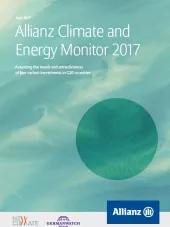The Allianz Climate & Energy Monitor Deep Dive aims to inform investors and policy-makers on the scale of investments needed in China, India and the US to be in line with the Paris goals; and what recent developments, especially regarding the leadership change in the US, mean for investing in renewable power in the future.
Key findings:
Investments in China and the US need to roughly double, in India even triple, to remain within the Paris Agreement warming limit.
Renewable power investments will need to rapidly grow in the coming two decades to be in line with the Paris Agreement targets. According to UNEP and Bloomberg New Energy Finance (BNEF), in 2016, combined investments in renewable electricity in China, India and the US amounted to USD 134 billion. These accounted for over half of the global investments in electricity supply in 2016.
China and India overshoot their renewable energy targets regularly and are exiting coal.
China aims to increase the renewable energy capacity by 38% in 2020 compared to 2015 levels, equaling 680 Gigawatt (GW) of installed capacities and investments of USD 361 billion in renewable energies. For comparison: Germany, which ranked first in the Allianz Climate & Energy Monitor 2016 for its renewable energy policies, currently has roughly 100 GW renewables installed. A new park of 10 wind mills has around 0.04 GW of capacity. India is also developing its renewable energy capacity at a rapid pace. In 2016, solar and wind installations exceeded the annual goal by 43% and 116% respectively. For 2022, India plans 175 GW of installed renewables. With market forces set into action by a clear policy intent, India is expected to comfortably achieve its climate targets.
Both countries are looking to exit coal-based power generation: China is cancelling plans for new fossil-based power plants and swiftly decommissioning existing coal power plants, while India is considering plans to stop building new coal power plants after 2022.
Staunch support for renewables in individual US states.
In the US, renewables are booming with more than 16 GW of wind and solar capacities installed in 2016, accounting for 60% of all new capacity (27 GW). This has been driven by ambitious Renewable Portfolio Standards in various US states and tax credit schemes on federal level as well as the decline in costs for renewables.
If the US drops out of the renewable triad mid-term, the EU could emerge as the third global pillar.
China, India and the US can play a leading role on the pathway to a global energy transition. But the outlook for federal policy ambition is worsening in the US from a climate perspective. For achieving the worldwide transformation with stable trends and good conditions another frontrunner is needed.





